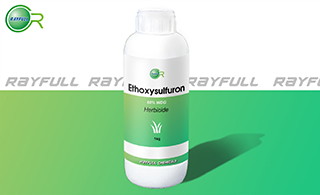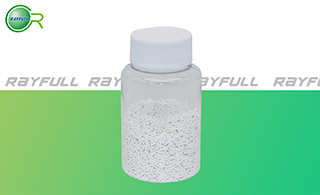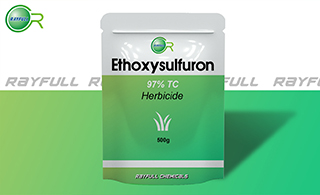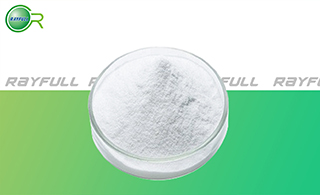ETHOXYSULFURON
    ТТСх»ЗВЎ, ТТСхаЧ»ЗВЎ ТТСх»ЗВЎ, ТТСхаЧ»ЗВЎ
Introduction: A herbicide used for broad-leaved weed and sedge control in a range of crops including cereals and rice.
Common name: Ethoxysulfuron
Another name: AC1MUTGY, etc.
Chemical name: 1-(4,6-dimethoxypyrimidin-2-yl)-3-(2-ethoxyphenoxysulfonyl)urea
Empirical formula: C15H18N4O7S
Structural formula:

Mol. Weight: 398.39 g/mol
CAS No.: 126801-58-9
Specifications
Leading Ethoxysulfuron supplier
Ethoxysulfuron 15% WDG
Ethoxysulfuron 60% WDG
Ethoxysulfuron 97% TC
Packing:
BULK PACKING
Solid: 25kg/Bag, 25kg/Drum, 50kg/Drum etc.
SMALL PACKING
Solid: 1kg/Alu bag, 500g/Alu bag, 200g/Alu bag, 100g/Alu bag, 50g/Alu bag, 15g/Alu bag etc.
Customerized packing label
Ethoxysulfuron FAO standard
Professional registration
HAZARDS IDENTIFICATION
Hazard statement(s)
H400 (100%): Very toxic to aquatic life.
H410 (100%): Very toxic to aquatic life with long lasting effects.
Precautionary statement(s)
P273: Avoid release to the environment.
P391: Collect spillage.
P501: Dispose of contents/container to ...
Supplemental Hazard Statements: none
MAMMALIAN TOXICOLOGY
Acute toxicity: 1) Acute oral LD50 for rat: 3270 a.i.mg/kg. 2) Acute dermal LD50 for rat: >4000 a.i.mg/kg. 3) Inhalation LC50 (4 h) for rat: 3.55 a.i.mg/L. 4) Non-irritating to skin (rabbits). 5) Non-irritating to eyes (rabbits). 6) Not a skin sensitiser (guinea pigs).
Not mutagenic (Ames).
ADI: 0.04 mg/kg b.w./day
Classification:
EC Risk Classification: N - Dangerous for the environment: R50, R53
ECOTOXICOLOGY
Effect on birds: low toxicity to birds, acute oral LD50 for Bobwhite quail is >2000 a.i.mg/kg. Effect on fish: moderate toxicity to fish, acute 96 hour LC50 for carp is > 80 a.i.mg/L. Effect on aquatic invertebrates: low toxicity to aquatic invertebrates, acute 48 hour EC50 for Daphnia magna is 307 a.i.mg/L. Effect on algae: moderate toxicity to algae, acute 72 hour EC50 for Raphidocelis subcapitata is 0.19 mg/L. Effect on honeybees: low toxicity to honeybees, contact acute 48 hour LD50 is >200 a.i.ҰМg/bee, oral acute 48 hour LD50 is >1000 a.i.ҰМg/bee. Effect on earthworms: low toxicity to earthworms, acute 14 day LC50 is >1000 a.i.mg/kg.
ENVIRONMENTAL FATE
Ethoxysulfuron's use as herbicide is expected to result in its direct release to the environment. If released to air, a vapor pressure of 0.066 mPa at 25 deg C indicates Ethoxysulfuron low volatility. Particulate-phase Ethoxysulfuron will be removed from the atmosphere by wet and dry deposition. Ethoxysulfuron has a photolysis half-life of 30 days at pH 7, it is stable in distilled, sterile water but photodegradation rapid in natural waters. If released to soil, Ethoxysulfuron is expected to have moderate mobility based upon an average experimental Koc of 134. Volatilization from moist soil surfaces is not expected to be an important fate process based upon experimental data and an estimated Henry's Law constant of 1.94ЎБ10-13 Pa m3/mol. EU dossier DT50 range 6-18 days (soil), 51 days (flooded paddy fields), DT90 range 59 -169 days, Field data DT50 range 14-21 days, DT90 range 46-69 days. If released into water, Ethoxysulfuron is not expected to adsorb to suspended solids and sediment based upon the Koc. Volatilization from water surfaces is not expected to be an important fate process based upon this compound's estimated Henry's Law constant. LogP <3 suggests the potential for bioconcentration in aquatic organisms is low.
Usage: Reported by E. Hacker et al. (Proc. Br. Crop Prot. Conf. - Weeds, 1995, 1, 73). Manufacturers: Bayer CropScience. Biochemistry: Branched chain amino acid synthesis (ALS or AHAS) inhibitor. Acts by inhibiting biosynthesis of the essential amino acids valine and isoleucine, hence stopping cell division and plant growth. Selectivity is due to differential metabolism in crop and weed (H Köcher & G Dickerhof, Proc. Br. Crop Prot. Conf. - Weeds, 1995, 1, 249). Metabolic basis of crop selectivity in sulfonylureas reviewed (M. K. Koeppe & H. M. Brown, Agro-Food-Industry, 6, 9-14 (1995)).
Application: Under development for broad-leaved and sedge weed control in cereals, rice and sugar cane, at 10-120 g/ha.
| 






